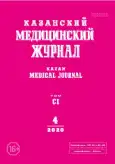Histomorphological changes in various rat tissues following chronic exposure to copper-zinc-pyrite ore
- Authors: Ziyakayeva KR1, Kayumova AF1, Kayumov FA1, Fazlyakhmetova MY.1
-
Affiliations:
- Bashkir State Medical University
- Issue: Vol 101, No 4 (2020)
- Pages: 524-529
- Section: Experimental medicine
- URL: https://journals.rcsi.science/kazanmedj/article/view/34188
- DOI: https://doi.org/10.17816/KMJ2020-524
- ID: 34188
Cite item
Abstract
Aim. To assess the histomorphological state of lung, gastrointestinal and kidney tissues following exposure to copper-zinc-pyrite ore in the long-term model experiment.
Methods. The study was performed on 60 outbred albino male rats, aged 3–4 months, weighting 200±30 g. The toxic effect of heavy metal salts of copper-zinc-pyrite ore on the animal's body was analyzed by the model of dosed oral injection of water with ore in a dose 600 mg/kg body weight for 120 days. Pieces of the stomach, small and colon, liver, lungs and kidneys were taken from control and experimental rats for histomorphological study on the 30th, 60th, 90th and 120th day of the experiment.
Results. The structural disorders of the stomach lining were observed on the 30th day of the experiment: desquamated and dilapidated epithelial cells appeared in the preparations. On the 120th day, along with signs of epithelial desquamation and diffuse lymphocytic infiltration, the preparations contained large lymphoid follicles that occupy the full thickness of the gastric mucosa. The epithelial layer of the small intestine mucosa was disrupted on the 60th day. At day 120 diffuse infiltration and necrotic changes in the lining of the small intestine were recorded. Lymphomacrophagia infiltrations were observed during portal triad and inside the liver wedges of experimental animals on the 30th day of the experiment. By the end of the experiment, toxic hepatocyte dystrophy developed. On the 60th day, signs of bronchopneumonia appeared in the lung tissue. After 3 months, tubulopathy and tubulointerstitial nephritis were observed in the experimental animals.
Conclusion. Prolonged administration of ore has led to pronounced inflammation and degenerative changes in the gastrointestinal tract, liver, kidney and lung tissues, accompanied by lymphocytic tissue reaction.
Keywords
Full Text
##article.viewOnOriginalSite##About the authors
K R Ziyakayeva
Bashkir State Medical University
Author for correspondence.
Email: klazia@yandex.ru
Russian Federation, Ufa, Russia
A F Kayumova
Bashkir State Medical University
Email: klazia@yandex.ru
Russian Federation, Ufa, Russia
F A Kayumov
Bashkir State Medical University
Email: klazia@yandex.ru
Russian Federation, Ufa, Russia
M Ya Fazlyakhmetova
Bashkir State Medical University
Email: klazia@yandex.ru
Russian Federation, Ufa, Russia
References
- Kamilov F.Kh. Osteoporoz: vliyanie khimicheskikh faktorov proizvodstvennoy sredy na metabolizm kostnoy tkani. (Osteoporosis. Effect of chemical factors in the production environment on bone metabolism.) Ufa: GUP RB Ufimskiy poligrafkombinat. 2015; 311 p. (In Russ.)
- Ostrovskaya S.S., Shatornaya V.F., Belskaya Yu.A. Effects of heavy metals and radiation on rat’s hemotosis. Mir meditsiny i biologii. 2014; 10 (4-2): 177–179. (In Russ.)
- Ryazantseva N.V., Novitsky V.V., Shperling I.A. Molecular disturbances in erythrocyte membrane at toxic effect produced by methemoglobin formers. Toksikologicheskiy vestnik. 2006; (4): 27–31. (In Russ.)
- Ryspekova N.N., Nurmukhambetov A.N., Askarova A.E., Akanov A.A. Role of heavy metals in anemia (Review). Vestnik Kazakhskogo natsionalnogo meditsinskogo universiteta. 2013; (3): 46–51. (In Russ.)
- Afanaseva E.Yu. Kaletina N.I. Toksikologicheskaya khimiya: metabolism i analiz toksikantov. (Toxicological chemistry: metabolism and toxicant analysis.) M.: GEOTAR-Media. 2008; 1015 p. (In Russ.)
- Nwokocha C.R., Nwokocha M.I., Aneto I. Comparative analysis on the effect of Lycopersicon esculentum (tomato) in reducing cadmium, mercury and lead accumulation in liver. Food Chem. Toxicol. 2012; 50 (6): 2070–2073. doi: 10.1016/j.fct.2012.03.079.
- Ilyasova R.R., Saptarov Yu.N., Knyazeva O.A. et al. Identification of heavy metal ions in blood plasma intoxicated by copper-zinc ore, using the method of atomic absorption spectrometry. Vestnik Bashkirskogo universiteta. 2018; 23 (2): 316–322. (In Russ.)
- Farshatova E.R., Ganeev T.I., Men'shikova I.A. et al. Influence of copper-zinc sulfide ores elements on bone tissue remodeling and regulative factors. Kazan Medical Journal. 2015; 96 (5): 783–787. (In Russ.) doi: 10.17750/KMJ2015-783.
- Ziyakayeva K.R., Kayumov F.A., Kayumova A.F. Morphological condition of the rat liver during intoxication with pyrite ore. Morfologiya. 2019; 156 (6): 97. (In Russ.)
- Ziyakayeva K.R., Kayumova A.F. Copper-zinc pyrite ore intoxication affects erythron of rats. Russ. J. Physiol. 2019; 106 (6): 780–789. (In Russ.) doi: 10.1134/S0869813919060128.
- Suldina T.I. The content of heavy metals in food and their effects on the body. Balanced diet, nutritional supplements and biostimulants. 2016; (1): 136–140. (In Russ.)
- Kayumova A.F., Kayumov F.A. Histomorphological examination of organs and tissues of experimental animals when exposed to chlorinated phenoxyacids. Zdravookhranenue Bashkortostana. 1996; (1): 13–17. (In Russ.)
- Goral V., Simsek M., Mete N. Hepatic osteodystrophy and liver cirrhosis. World J. Gastroenterol. 2010; 16 (13): 1639–1643. doi: 10.3748/wjg.v16.i13.1639.
- Mohammad M.K., Zhou Z., Cave M. Zinc and liver disease. Nutr. Clin. Pract. 2012; 27 (1): 8–20. doi: 10.1177/0884533611433534.
- Ibrahim N.M., Eweis E.A., El-Beltagi H.S., Abdel-Mobdy Y.E. The effect of lead toxicity on experimental male albino rat. Biol. Trace Elementary Res. 2011; 144 (1–3): 1120–1132. doi: 10.1007/s12011-011-9149-z.
- Tishevskaya N.V., Gevorkyan N.M., Kozlova N.I. The role of T-lymphocytes in hormonal regulation of morphogenetic processes. Uspekhi sovremennoy biologii. 2015; 135 (2): 189–202. (In Russ.)
- Tishevskaya N.V., Gevorkyan N.M., Kozlova N.I. A modern view of the role of T-lymphocytes in regulation of erythropoiesis. Uspekhi sovremennoy biologii. 2016; 136 (1): 83–96. (In Russ.)
Supplementary files











